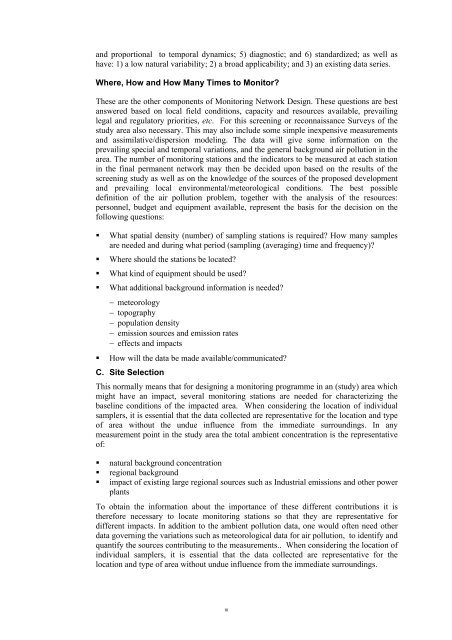Distillieries - Environmental Clearance
Distillieries - Environmental Clearance
Distillieries - Environmental Clearance
Create successful ePaper yourself
Turn your PDF publications into a flip-book with our unique Google optimized e-Paper software.
and proportional to temporal dynamics; 5) diagnostic; and 6) standardized; as well ashave: 1) a low natural variability; 2) a broad applicability; and 3) an existing data series.Where, How and How Many Times to Monitor?These are the other components of Monitoring Network Design. These questions are bestanswered based on local field conditions, capacity and resources available, prevailinglegal and regulatory priorities, etc. For this screening or reconnaissance Surveys of thestudy area also necessary. This may also include some simple inexpensive measurementsand assimilative/dispersion modeling. The data will give some information on theprevailing special and temporal variations, and the general background air pollution in thearea. The number of monitoring stations and the indicators to be measured at each stationin the final permanent network may then be decided upon based on the results of thescreening study as well as on the knowledge of the sources of the proposed developmentand prevailing local environmental/meteorological conditions. The best possibledefinition of the air pollution problem, together with the analysis of the resources:personnel, budget and equipment available, represent the basis for the decision on thefollowing questions:What spatial density (number) of sampling stations is required? How many samplesare needed and during what period (sampling (averaging) time and frequency)?Where should the stations be located?What kind of equipment should be used?What additional background information is needed?− meteorology− topography− population density− emission sources and emission rates− effects and impactsHow will the data be made available/communicated?C. Site SelectionThis normally means that for designing a monitoring programme in an (study) area whichmight have an impact, several monitoring stations are needed for characterizing thebaseline conditions of the impacted area. When considering the location of individualsamplers, it is essential that the data collected are representative for the location and typeof area without the undue influence from the immediate surroundings. In anymeasurement point in the study area the total ambient concentration is the representativeof:natural background concentrationregional backgroundimpact of existing large regional sources such as Industrial emissions and other powerplantsTo obtain the information about the importance of these different contributions it istherefore necessary to locate monitoring stations so that they are representative fordifferent impacts. In addition to the ambient pollution data, one would often need otherdata governing the variations such as meteorological data for air pollution, to identify andquantify the sources contributing to the measurements.. When considering the location ofindividual samplers, it is essential that the data collected are representative for thelocation and type of area without undue influence from the immediate surroundings.iii

















